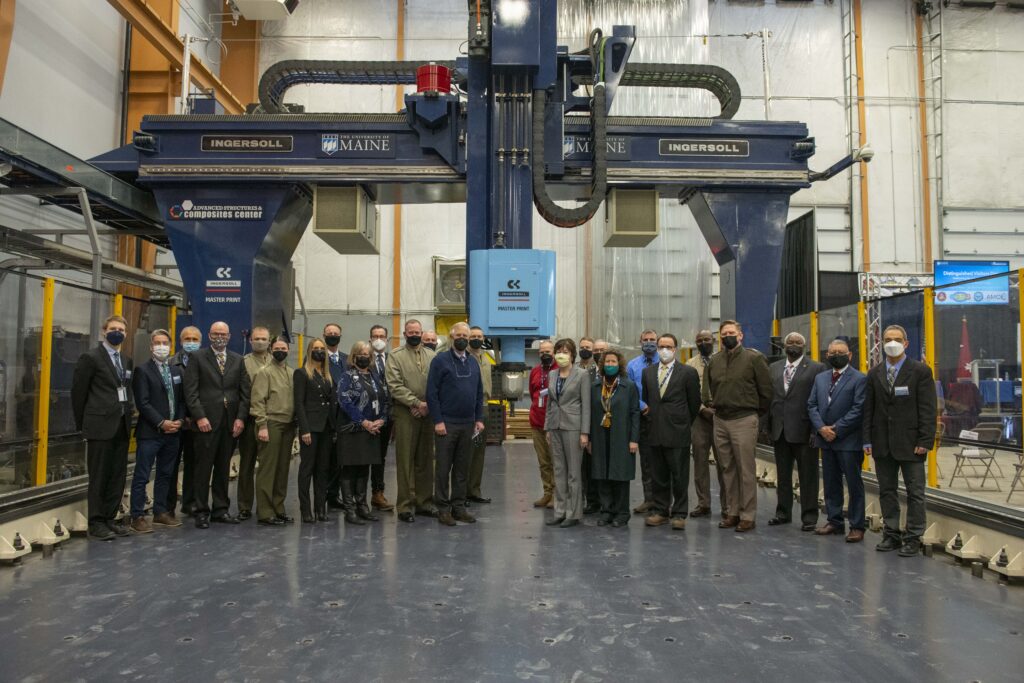
ORONO, Maine — The world’s largest polymer additive manufacturing machine printed the world’s largest 3D printed vessel at the University of Maine’s Advanced Structures and Composites Center in Orono, Maine. In fact, it printed two of them.
The prototype vessels were built with Marines in mind. One of the two logistics support vessels can carry a pair of 20-foot shipping containers, while the other can transport a Marine rifle squad with three days of food, water and supplies.
This isn’t the first time the UMaine Composites Center printed a vessel. In 2019, the Center printed 3Dirigo and earned two Guinness World Records — the world’s largest 3D printed boat and the world’s largest 3D printed object. The 25-foot, 5,000-pound boat was printed in 72 hours. “Dirigo” is the motto of the State of Maine and means “I lead” in Latin.
The two new vessels are multi-material composites with engineering polymer and fiber reinforcement. The composites center fabricated and assembled one of the vessels in a month instead of up to year, which is typical using traditional methods and materials.
The university hosted a ceremony attended by the state’s two senators, Republican Susan Collins and Independent Angus King, along with representatives from the Defense Department on Friday, Feb. 25, to mark the production of the vessel. In a statement issued by the senators and university, the achievement was called “a significant milestone towards demonstrating advanced manufacturing techniques to rapidly constitute critical DoD assets closer to the point of need.”
Due to national security concerns, no photos or video of the boats was allowed.
‘The Future of Manufacturing’
“Marine Corps Systems Command’s Advanced Manufacturing Operations Cell, in collaboration with the UMaine Composites Center, used advanced manufacturing techniques to successfully develop the expendable polymeric composite ship-to-shore vessels,” the statement says. “The longer of the two vessels, the largest ever 3D-printed, simulates ship-to-shore movement of 20-foot containers representing equipment and supplies. The second vessel can transport a Marine rifle-squad with organic equipment and three days of supplies. The prototypes can be connected, maximizing the transport capability of a single-tow vehicle.”
“This is literally the future of manufacturing that’s happening right here at the University,” King said.
The Marine Corps established the Advanced Manufacturing Operations Cell in 2019 to support Marines with new advanced manufacturing and technologies and techniques, as well as to conduct testing, experimentation and analysis.
Multiple small logistics vessels will be needed by the Navy-Marine Corps team to support distributed maritime operations and expeditionary advanced base operations.
“This project demonstrates the art of the possible and the potential for AM [additive manufacturing] to fundamentally alter how we think about connectors and their role in mobility and distribution within a contested environment,” said Lt. Gen. Edward Banta, Deputy Commandant – Installation & Logistics, U.S. Marine Corps.
“The University of Maine is at the forefront of cutting-edge research and high-impact technologies, including advanced manufacturing, AI and 3D printing important for industries in Maine and beyond,” said University of Maine System Chancellor Dannel Malloy. “These prototype vessels are the latest innovations from the Composites Center that demonstrate the future of manufacturing.”
“Two years ago, we demonstrated that it was possible to 3D print a 25-foot patrol vessel in three days. Since then, partnering with the DOD, we have been improving material properties, speeding up the printing process and connecting our printer with high-performance computers that can monitor the print. With these tools in place, we have now printed a prototype vessel that will be tested by the U.S. Marine Corps.”
From the lab in Orono, the boats will travel next go to California for sea testing and evaluation.
- A Day to Remember - September 11, 2023
- Indo-Pacific Maritime Security Exchange will examine emerging capabilities and capacity - July 12, 2023
- Cold Waters Spark Warm Relationship - April 20, 2023






